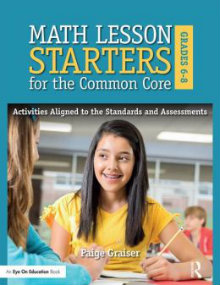Math Lesson Starters to Use Right Now
Math Lesson Starters for the Common Core: Grades 6-8
Activities Aligned to the Standards and Assessments
By Paige Graiser
(Routledge/Eye on Education, 2014 – Learn more)

Many teachers use bellringers or sponges to start their classes. Doing so allows them to complete administrative tasks while students are doing an activity that can act as a formative assessment. The book Math Lesson Starters for the Common Core: Grades 6-8 provides a great variety of perfect questions for this type of activity.

Because the questions are designed to take five minutes or less, teachers can also use them to quickly assess whether students have the necessary background information for a new lesson or if there are any misconceptions about previously taught concepts.
Many of the bellringers also require that students use literacy strategies to understand and answer the questions. For management purposes, Lesson Starters give teachers the time to take attendance and do other administrative tasks while students complete a worthwhile task.
More details about the content
The rest of the book is arranged by CCSS-M domains: Ratios and Proportional Relationships, The Number System, Expressions and Equations, Geometry, and Statistics and Probability. For the teacher, each chapter begins with a description of the domain for each grade level and ends with a page for the teacher to reflect on their use of the lesson starters. For the student, each chapter begins with key vocabulary terms.
At least 13 sponge activities per standard are provided. There is frequent use of graphic organizers to both share information and to organize answers. Each page is very clean in appearance, making it easy to use on a whiteboard with a document camera or to copy onto a transparency for use with an overhead projector.
A grade level is not provided for each activity so the teacher must pick and choose based on their knowledge of their grade level standards. A few can be used across grade levels. As a busy teacher, I feel that the book does a wonderful job of providing ready-to-use problems that work as formative assessment.
Using starters with multiple topics
There is a sixth chapter entitled “Lesson Starters to Use with Multiple Math Topics.” Journal topic starters, a student reflection sheet for days with a substitute teacher, a flashcard format, Carroll Diagrams, Alphabet Boxes, and a Review/Preview form are all found in this chapter. These could be used with any unit of study. Using them on a regular basis with various units will give students tools they can use, not only in math but in many subjects, for learning and for reviewing a myriad of topics.
It’s a short book!
The book does all of this in 122 pages. Paige Graiser has created a quick-to-read and ready-to-use resource. As a teacher working with at-risk math students for about 20 minutes each day, I plan to use these activities as they are written and as models to create more problems. This is a great book for both new and experienced teachers who would like to have their students do something meaningful and productive at the beginning of class. I highly recommend it as a CCSS-M resource.
Lynne Menechella is currently an AIS math teacher in the Horseheads (NY) Central School District for Grades 5 – 8. She has a B.S. in Mathematics from William Smith College and a M.Ed. from Elmira College. With the district since 1984, she has also been a 7th grade math classroom teacher, an instructional support teacher, a team leader and a department chair. In addition, she was a NYS Math Mentor for several years. Lynne is married and has two adult children.


































